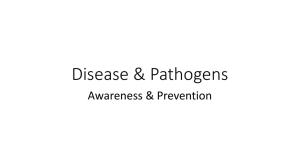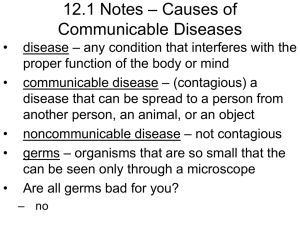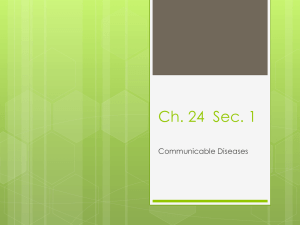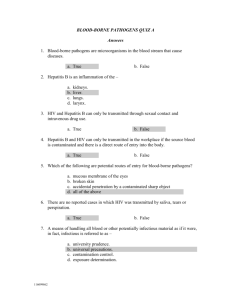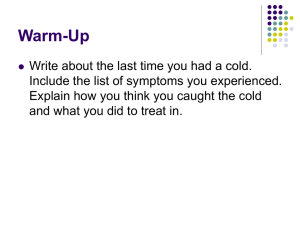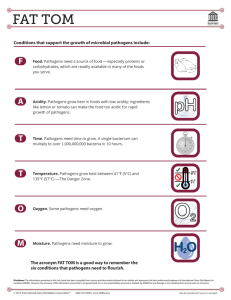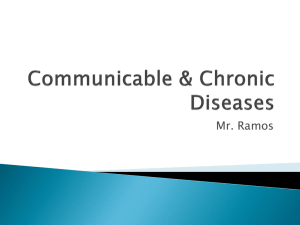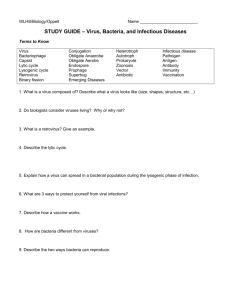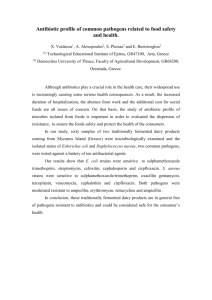Chapter 24 - North Mac Schools
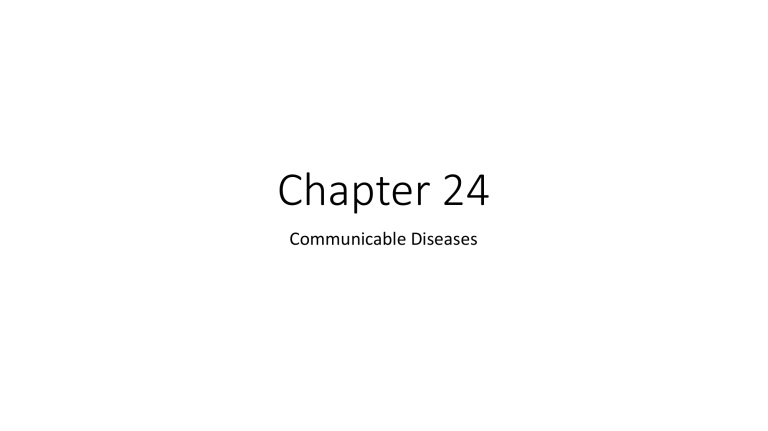
Chapter 24
Communicable Diseases
Lesson 1 – What Are Communicable Diseases?
1. What is a communicable disease?
• A disease that is spread from one living thing to another through the environment.
2. Why is it important to know how communicable diseases are spread?
• To reduce your risk of getting them.
3. Provide a brief description of and name 2 diseases caused by each of the following pathogens.
Viruses
• Pieces of genetic material surrounded by a protein coat. Need living cells to reproduce.
• Common cold and influenza (flu).
Lesson 1 - continued
Bacteria
• Single-celled microorganisms that live almost anywhere on earth.
• Strep throat and bacterial foodborne illness.
Protozoans
• Single-celled organisms that are larger and more complex than bacteria. Most are harmless.
• Malaria and amoebic dysentery.
Fungi
• Plant-like organisms such as molds and yeast.
• Athlete’s foot and ringworm.
Lesson 1 - continued
Rickettsias
• Resemble bacteria. Often enter humans through the bite of an insect.
• Typhus and Rocky Mountain Fever.
Examples
Lesson 1 - continued
4. Describe 3 ways a communicable disease can be transmitted by
INDIRECT CONTACT.
• Contaminated objects – door handles, desks, and computer keyboards.
• Vectors – tick or mosquito.
• Water and food – undercooked food and contaminated water supply.
5. How is airborne transmission of pathogens different from transmission by direct contact?
• DIRECT CONTACT – Touching, biting, and kissing. Also, sneezing and coughing can spray a nearby person.
• Airborne transmission – Different from direct contact because pathogens don’t settle quickly on surfaces. May travel long distances.
Lesson 1 - continued
6. What is the most effective way to prevent the spread of communicable disease?
• Washing hands.
• Handling food properly.
7. List 5 measures that will help prevent the of foodborne illness.
• Always wash hands before handling food.
• Use paper towels in place of dish cloths/sponges.
• Keep surfaces and equipment clean.
• Separate raw meat and other food.
• Chill cold and leftover food quickly.
Lesson 1 - continued
8. How does a balanced diet and regular exercise help prevent the spread of disease?
• The healthier the body, better able to resist infection.
9. What is the role of stress in the spread of disease?
• Makes you vulnerable to illness.
Lesson 2 – Preventing Communicable Diseases
1. What is the immune system?
• Network of cells, tissues, organs, and chemicals that fights off pathogens .
2. How do physical barriers protect the body from pathogens? How do chemical barriers protect the body from pathogens?
Physical barriers
• Block pathogens from invading your body.
Chemical barriers
• Destroy pathogens.
3. How does the inflammatory response involved in fighting pathogens?
• Prevent further tissue injury and halt invading pathogens.
Lesson 2 - continued
4. Complete the following outline of the body’s specific defenses.
Lymphocytes
A. T cells
1. Helper T cells – trigger the production of B cells and killer T cells.
2. Killer T cells - attack and destroy infected body cells.
3. Suppressor T cells coordinate T cell activity, turn off helper T cells.
B. B cells – produce antibodies.
C . Memory Lymphocytes – circulate in the blood stream for years, provide long-term immunity.
Lesson 2 - continued
5. What is the difference between active and passive immunity?
• Active immunity – body produces its own antibodies, exposed to invading pathogens or a vaccine.
• Passive immunity – when a person receives antibodies from another person. For example, mother passes to child during pregnancy.
6. List 5 behaviors that will help you maintain a healthy immune system.
• Eat nutritious meals and drink 6 to 8 glasses of water each day.
• Get plenty of rest.
• Get plenty of physical activity and avoid sharing personal items.
• Avoid tobacco, other drugs, and sexual contact.
• Keep immunizations up to date.
Lesson 2 - continued
7. List the 4 types of vaccines mentioned in the lesson.
• Live-virus vaccines.
• Killed-virus vaccines.
• Toxoids.
• New and second – generation vaccines.
8. How do vaccines benefit people other than those who received vaccination? Does this benefit exist for all communicable diseases?
• You cannot get a disease if you have been vaccinated……you cannot spread the disease to other people.
• Only true for diseases that are spread person to person.
Lesson 2 - continued
9. In what way do toxoids prevent disease?
• Use inactivated toxins from pathogens to stimulate the production of antibodies.
Lesson 3 – Common Communicable Diseases
1. Write a brief summary of the symptoms and treatments for each of the following respiratory infections.
Common cold (viral infection)
• Running nose, sneezing and sore throat.
• Treatment is for relief of symptoms, use ibuprofen instead of aspirin.
Influenza (viral infection)
• High fever, fatigue, head ache, muscle aches, and cough.
• Anti-viral drugs are available but must be as soon as 1 st symptoms arise.
Pneumonia (viral and bacterial)
• Similar to those of the flu.
• If bacterial, can be treated with antibiotics. If viral, anti-viral drugs can be used.
Lesson 3 - continued
Strep Throat (bacterial infection)
• Sore throat, fever, and enlarged lymph nodes in the neck.
• Treated with antibiotics.
Tuberculosis
• Fatigue, coughing (sometimes bloody), fever, night sweats, and weight loss.
• Some strains of TB are drug resistant, so doctors use different antibiotics.
2. What is hepatitis?
• It is an inflammation of the liver.
Lesson 3 - continued
3. What is the mode of transportation for the hepatitis A virus? The hepatitis B virus? The hepatitis C virus?
Hepatitis A
• Most commonly spread through contact with feces of an infected person.
Hepatitis B
• Found in most bodily fluids of an infected person.
Hepatitis C
• Direct contact with infected blood through dirty needles shared by drug users.
Lesson 3 - continued
4. Describe 3 factors that contribute to emerging infections.
• Transport across borders.
• Population movement.
• Resistance to antibiotics.
• Changes in food technology.
• Agents of bioterrorism.
